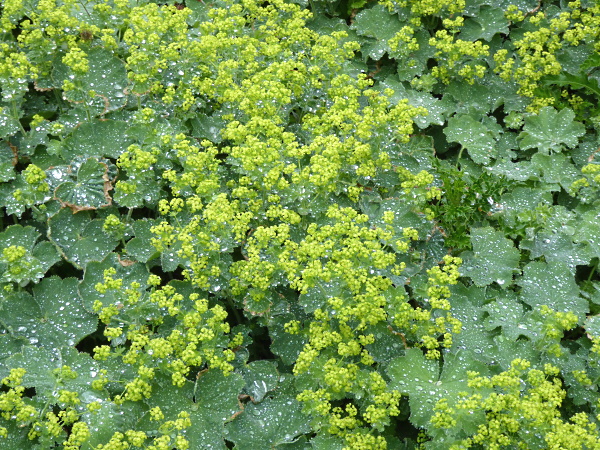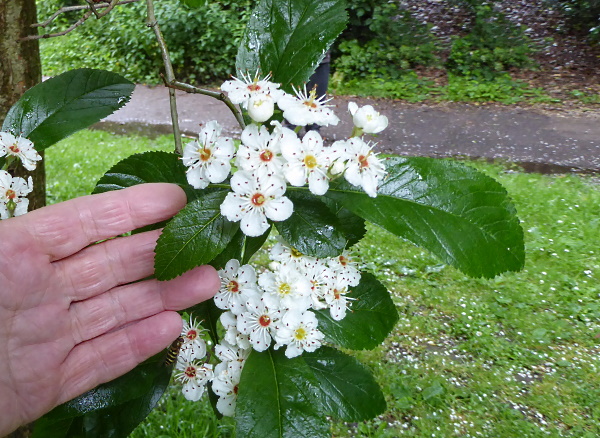
We were hoping to attend the Picnic in the Park, part of the Big Jubilee Lunch, organised by the Friends of Birkenhead Park to celebrate the Queen’s Platinum Jubilee and the 175th anniversary of the opening of the park. Sadly after three days of lovely weather, on Sunday it rained nearly all day. There was no sign of any gathering, and we were later told it had been officially cancelled that morning, and clearly nobody would be lounging on the grass with bubbly in that weather! But it was interesting to visit the park at a different season and see things we had never noticed before. One was by the obelisk called the Jackson Memorial. An unassuming pair of bushes turned out to be Chinese Dogwoods with their gorgeous flowers.

There were no interesting birds on the lake, just Mute Swans, Canada Geese, Mallards, Coots and Moorhens. At the west end of the lake, near the rockery, the Cucumber tree was in subdued flower.

On the opposite side of the lake a pair of Moorhens were building a nest about 10 feet (3 meters) above the water on an overhanging branch of a Deodar cedar. It will be fun when the chicks have to jump!

The drizzly rain became heavier, so we sheltered in the Visitors’ Centre where there was an art exhibition.


When the rain eased off, we headed back out. Near the Swiss Bridge was a yellow-flowered ground-cover plant on the lakeside, with the rain beading prettily on the leaves. It’s Garden Lady’s Mantle Alchemilla mollis, not strictly a wild flower, but a “neophyte”, which has naturalised in the last century. The Victorians kept it in their gardens, and it escaped in WWII. This has probably been planted in the park, rather than arriving at random.

The trees flowered early this year and good numbers of seeds are already forming. We noted both Sycamore helicopters and Horse Chestnut conkers growing well, and this Beech was getting heavy with seed cases.

Another example of us previously overlooking something was a modest small tree on a path corner. It was blossoming rather like Hawthorn, but the flowers were bigger and later than hedge mayflowers. I think it might be Hybrid Cockspur Thorn Crataegus x lavallei. The leaves are the right shape (not broad-leaved) while Mitchell’s tree book mentions the prominent red disc in the centres of the flowers as a key identification feature. No thorns, though.

After lunch in the Boat House (the only available shelter) we went around the Upper Park, where a Song Thrush was singing. We had seen Crows, Magpies and Wood Pigeons, but all the little birds were hiding away. Grey Squirrels seemed to be very hungry, because they gathered around us, three or four at a time, whenever we stopped to look at something. Something brown flashed across the path in front of us. A Stoat? Or was it just a Rat? Through the thick shrubbery a tall Laburnum tree was blooming magnificently. It’s rather late, so maybe the shady position has held it back.

Across the big field the clump of Purple Cherry Plums Prunus cerasifera ‘Pissardi’, were floating serenely in the slight damp mist. They feature in the Friend’s big leaflet “The Unusual Trees of Birkenhead Park”.

We returned on the train from Birkenhead Park Station, where the railsides were lovely with wild flowers. The westbound side was all dainty white, with white Dog Rose, Ox-Eye Daisy and Cow Parsley, while the eastbound side was more dramatic. I can’t identify most of this, and at first I thought the lowest plant was Shining Cranesbill because it was so red, but it is probably just Herb Robert, reddening under the influence of all that limestone ballast.

Public transport details: Bus 437 from Sir Thomas Street towards West Kirby at 10.19, arriving Park Road North / Park Road East at 10.32. Returned on the train from Birkenhead Park Station at 2.21, arriving Liverpool Central at 2.34
